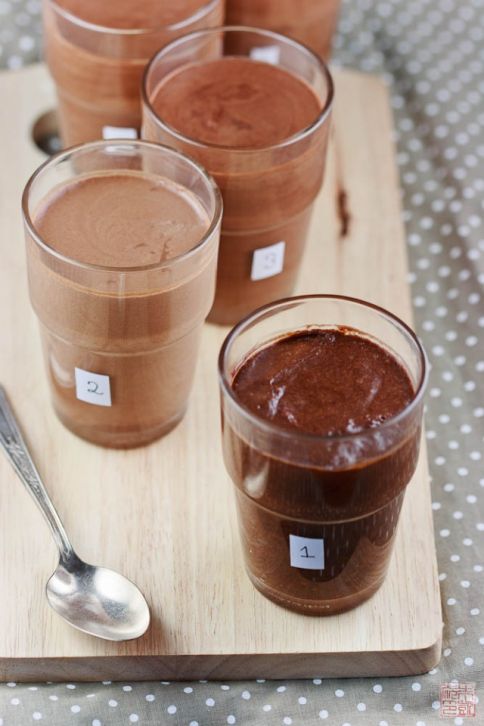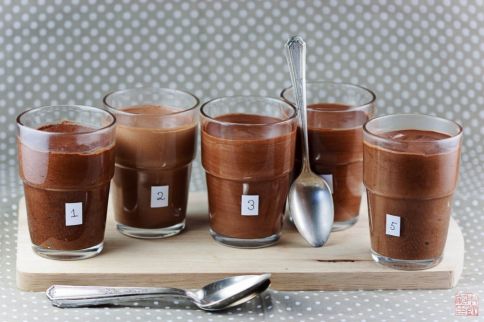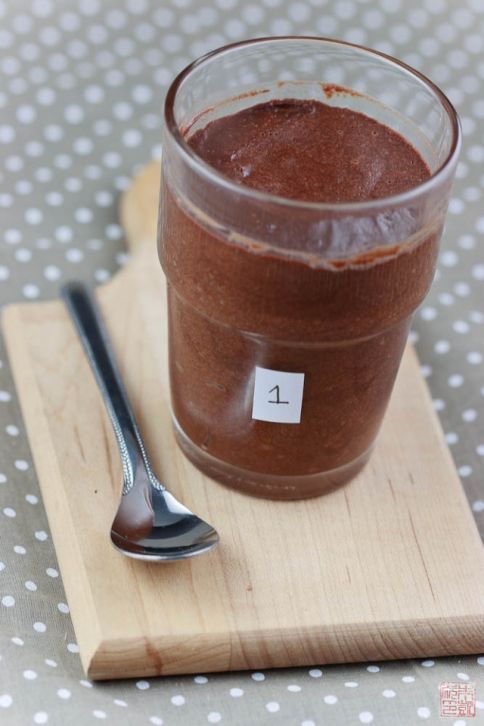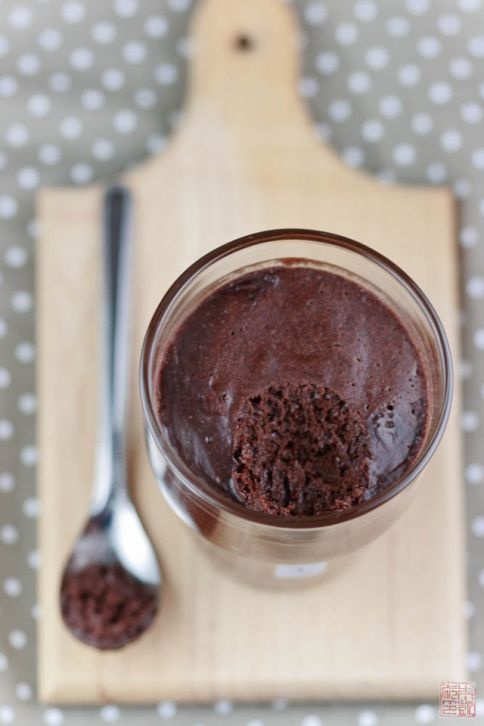Sometimes you find yourself in an inspiration drought. I know that seems practically impossible these days, when Facebook and Twitter and Pinterest means there’s all sorts of inspiration for the taking, all the time, but sometimes I find the reverse happening. When you’re surrounded by everyone else’s cool ideas, and it seems like everything original has already been done, it’s hard to have room for creative thoughts of your own in your mind. Sometimes I find I need to step away from the overstimulation and let my brain wander and percolate ideas on its own. Like the classic writers’ advice, to stop reading when you’re trying to write your own book, so you don’t let other voices drown out your own.
I can’t guarantee that the project I came up with is wholly original, but at least it was a happy kickstart. I tried to re-organize my bookshelf for the tenth time (I keep coming up with new algorithms for determining hierarchy) and ended up picking out Cooking with Chocolate: Essential Recipes and Techniques, which was a nominee for IACP best baking book of 2011. I concur with the short-listing: it’s a comprehensive compendium of classic chocolate techniques, easy to follow, and written in English – that last criterion can be a real killer when searching for advanced/professional level baking books!
Leafing through the book, I came across an entire chapter of mousses, which immediately perked my instinctive need to compare and contrast all the versions of a dish to find the best one. The chapter notes indicated that, “each mousse here has a different intensity and should be tasted and used differently”, which sealed the deal for me – this was my weekend project!
Over the next couple of days I made five mousse recipes from the book, tasted and contemplated, and tried to write down adjectives other than “creamy”, “rich”, and “delicious”. I’m going to post a recipe a day for the next five days, and share my thoughts on each different preparation.
Nota bene: there are many more ways to make chocolate mousse recipes than five – I simply chose several from the book that looked intriguing, plus I didn’t have enough chocolate in my pantry (hey, I’ve been baking a lot with chocolate recently). If you have a favorite chocolate mousse recipe, by all means write me a comment and let me know! Also, the comments on all the recipes are my own observations and not the book’s – my heartfelt suggestion is to make all the recipes yourself, and come back here and post your opinions:)
On to the first mousse!
Chocolate Mousse #1: Egg White Based
The first chocolate mousse recipe is described (a little non-sexily) as egg white based, which just means that the mousse is lightened by folding in whipped egg whites. (All the other mousses I tried are lightened by folding in whipped cream, if that helps clear things up). This mousse is probably best known as French-style chocolate mousse, and numerous versions can be found in many a classic cookbook – some have butter, some omit the cream, but all depend on eggs to provide richness of body and flavor.
The eggs are not cooked in this recipe though, so French-style chocolate mousse should considered carefully by those with possible health concerns. However, as all the rest of the mousse recipes to follow are raw egg-free, there’s no need to feel left out!
This is probably my favorite mousse for just eating – its texture when fresh is that perfectly elusive combination of airy and melting, and the chocolate flavor is intense – exactly what you want when you need a good hit of chocolate. It has a lasting, sweet finish, slightly dry on the tongue. You can see in the lineup in the top photo that it’s the darkest mousse by far – probably since it hasn’t been lightened up with whipped cream like that others (don’t think I’m writing off all the other versions – they have their virtues which I’ll get to in the next days!). It just has that very appealing “chocolately” look.
This mousse recipe comes with a warning to eat within 24 hours, because of the raw egg yolks, but I think there’s another reason as well: it really taste best fresh. The mousse will thicken more and more as it chills, so if you prefer a very soft, creamy mouthfeel, you can serve it after just a couple hours of chilling. After several more hours, it will develop a firmer, more springy texture that is the hallmark of this style of mousse. It’s best to let the mousse sit at room temperature for about 30 minutes before serving, to let it soften slightly. This mousse, or some version of French style chocolate mousse, is definitely one to have in your back pocket when you have surprise guests over.
Hope you enjoy! Come back tomorrow (yes, tomorrow!) for round two!
- adapted from Cooking with Chocolate
- 11 2/3 oz (330 g) bittersweet (60-68%) chocolate, finely chopped
- 2/3 cup (150 ml) whipping cream
- 3 large egg yolks
- 6 large egg whites
- 1/4 cup (50 g) sugar
- Place chocolate in a heatproof bowl and melt over a pot of simmering water. Remove from heat and set aside.
- Bring cream to a boil in a heavy saucepan. Remove from heat. Pour about one-third into the chocolate and whisk quickly to combine.
- Pour in another third of the cream and whisk to combine. Pour in the remaining cream and whisk to combine. The mixture should be very smooth and shiny and feel slightly elastic like thick pudding - this is the sign of a proper emulsion.
- Add in the egg yolks and beat to combine.
- Combine egg whites and sugar in a stand mixer and whisk with the whisk attachment until soft peaks form.
- When the chocolate mixture has cooled to 113-122 degrees F, fold in a quarter of the whipped egg whites to lighten. Add the rest of the egg whites and fold to combine.
- Divide mousse among dessert glasses and chill for 12 hours. Serve within 24 hours because of the raw egg yolks.






Looks absolutely delicious! I can’t wait to read about the other mousse variations 🙂
What an awesome idea! I always make my mousses with egg whites and cream, but I usually just make up the quantities as I go along. I’ll be interested to see how your five turn out 🙂
These mousses look delicious and I will try them all, although I am partial to the french-style. However, the book- Cooking with Chocolate- is actually a french book that has been translated into english. And not very well done either. There are many translation errors and I find that the directions are a bit off. But the pictures are gorgeous and if nothing else, a wonderful book to stare at!
Hi Erica,
I’m not surprised it was originally written in French, with all those French pastry chefs contributing! I find the translation decent and more approachable than some other professional level books, where you pretty much need to know the classic pastry techniques already since the instructions are minimal. Thanks for the tip about errors though, I’ll keep an eye but fortunately didn’t have a problem with the mousses!
well I cannot wait to see the rest, I love mousse!
Awesome! So we can expect 4 new mousse recipes popping up soon? Love it!
Oh yes!! These looks delicious, can’t wait to try this yummy dessert out. I love chocolate and in the mouse form is even better.
What a fun exercise. Looking forward to seeing the variations between mousses.
What a great project! I loved your description- I could imagine every detail of the taste..yum!
Ooh la la lovely! Can’t wait for the new magazine.
I’m not sure if anyone’s mentioned this, but some grocery stores sell pasteurized eggs, which would be a safe alternative to raw eggs. You can also pasteurize your own at home, which is what I do! And if you happen to accidentally cook any part of the egg, just remove that little cooked bit before using the white/yolk 🙂
Kelly,
Thanks for the great tip! I haven’t tried using them but it’s definitely a great option!